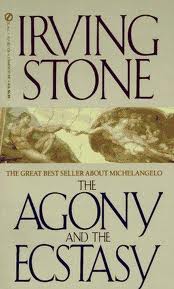The Agony and the Ecstasy by Irving Stone
Reviewed by Jennifer

Ratings Explanation
Violence: Torrigiani punches Michelangelo in the nose, breaking it. Mob violence. Some brief descriptions of war. A cart carrying a large marble slab runs out of control and kills a man.
Sexual Content: Comments about “bad women” and “whores”. Artist’s creation of sculpture equated with the creation of life using words like “thrust”, “penetration”, “climax” and “insemination”. Vague references to characters being with women and prostitutes. Michelangelo longs for another man’s mistress. He eventually has a sexual relationship with her, more sexual language, “penetrating”, “thrusting”, etc. A character points out that there are 7,000 public women in Rome. He refers to “hunting” among them and choosing one for “the act”. Brief discussion of sculpting David’s erogenous zone. Pretty girls referred to as “mattressable”. Michelangelo invites a prostitute to go home with him. Some sexuality in art discussed. Michelangelo is accused of having an inappropriate relationship with a much younger man.
Adult Themes: Michelangelo secretly dissects many bodies. There are rather graphic descriptions of organs and the inner workings of the body. Intrigue within the Catholic church. It is mentioned frequently that Popes fathered children. Horrors of The Spanish Inquisition.
Synopsis
The Agony and the Ecstasy begins with 13-year-old Michelangelo in Florence, Italy and follows his long and fascinating life until his death at age 90 in Rome. Readers may be surprised to learn of the many and varied roles Michelangelo played during his lifetime. Most will be familiar with his sculptures and paintings, but he was also an engineer, architect, road builder, defense engineer, wood carver and worker of bronze. His true love was always the sculpting of marble, but he was, in some cases, forced to explore his talents in other areas.
Irving Stone recreates the wonders and struggles of Renaissance Italy, focusing on Michelangelo’s life and weaving in other icons from the time, including DiVinci, Raphael, and the de’Medici family. A very detailed historical account, as well as an in-depth study of the great artist, The Agony and the Ecstasy explores the personalities and factors that molded Michelangelo Buonarroti’s development and his triumph as an artist whose works of art have become immortal.
First let me say that I really enjoyed this book and my time reading it was definitely well spent. One of my main impressions of Michelangelo was his commitment to giving his best effort to each piece of art he created. Throughout his life, he strove to be true to himself and to God, from whom he recognized his talent came. He was unwilling to compromise quality for speed or compensation and viewed this as a matter of integrity. From the book, “He had never compromised with quality; his integrity as a man and an artist was the rock on which his life was built. If he split that rock by indifference, by giving less than the exhausting best of himself, if he were content merely to get by, what was left of him?” A lesson that many of us could learn from.
The historical setting is also fascinating. At times it feels less like a story and more like a history lesson, but for the most part the narrative carries the reader right along, wondering how Michelangelo will solve his next challenge, negotiate with the next Pope, or get enough money to pay for marble – and food. Before reading this book, I thought of the Renaissance masters living in a world where they were free to spend all their time creating without worrying about the mundane minutia of life; that was not the case for Michelangelo. In fact, it is a little surprising that he finished any of his creations, considering all of the other things he had to worry about. For example, one of the Popes wanted sculptures carved from marble originating from a certain quarry, but there was no road to this particular quarry. The Pope then ordered Michelangelo to build a road. Michelangelo was an artist, not a road builder, but he engineered a road, assembled a crew, supervised each phase, changed plans to build a more efficient road and eventually extracted a few marble slabs for the Pope, only to see them sit on the beach unable to get them transported. With only a few exceptions, Michelangelo suffered in some way to produce each work. This knowledge has changed how I look at his art.
An excellent book well worth reading! It is a work of literature that has enriched my life. Appropriate for high school students and older.









